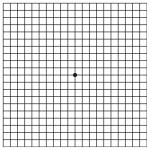Macular Degeneration
The central part of the retina, the macula, is responsible for sharp colour vision. Damage to the macula may arise due to accumulation of cellular debris under the retina (dry macular degeneration) or formation of new blood vessels under the retina (wet macular degeneration). Both of these can lead to damage to the cells that process light into images.
Age-related macular degeneration (AMD) is the leading cause of vision loss and legal blindness in Australia.
It affects about 1 in 7 Australians over the age of 50, with approximately 17% of these people experiencing vision impairment.
Almost 15% of people over the age of 80 experience severe vision loss from AMD.
Risk Factors
Age, family history and smoking are key risk factors for developing AMD. Those with a direct family history (mother, father or siblings) have a 50% chance of developing AMD, and at least 70% of cases of AMD have a genetic link. Those who smoke also have a 3-4 times greater risk of developing AMD compared to non-smokers, and have been shown to develop late stage AMD up to 10 years earlier than non-smokers.
Signs & Symptoms
Changes in early stage AMD usually have little or no impact on vision. In the later stages, AMD can present as changes to your central vision through to sudden loss of vision in one eye, which may go unnoticed if the vision in the other eye is good. In addition, dry AMD may later progressive to the more serious wet AMD if undetected or untreated. Regular eye checks, especially in those over 50, are important in detecting these changes.

Amsler Grid Eye Test
If you think you could be experiencing macular degeneration, there is a brilliantly simple self-test called the Amsler Grid. It is made up of a grid of horizontal and vertical lines, and if the lines you see are distorted or have missing patches, you likely have a disease of the macula.
Download a PDF with the grid and instructions.
Prevention, Treatment and Prognosis
A healthy diet and lifestyle are important in maintaining good eye health and preventing the onset or progression of AMD. Having a healthy intake of vitamins and minerals like lutein and zeaxanthin (found in dark leafy greens), and omega 3 (found in fish, nuts and seeds), as well as low-GI foods like fresh whole fruits and vegetables all help prevent dry and wet AMD and improve your overall health.
Dry AMD usually only requires monitoring, as well as education of the warning signs of wet AMD and maintaining a healthy diet and lifestyle. Vitamin supplements like Macuvision may be prescribed to slow the disease. Wet AMD requires treatment with intravitreal injections into the eye to make the abnormal blood vessels in the eye regress.
Dry AMD progresses over years to decades, and if detected early, it’s impact can be minimised. Wet AMD progresses more quickly over weeks and months and requires treatment to stabilise the disease, stop progression and reverse vision loss. With regular check ups and treatment, AMD has a good prognosis and your vision can be maintained.
Get in touch today to request an appointment or to ask a question about a specific procedure.






